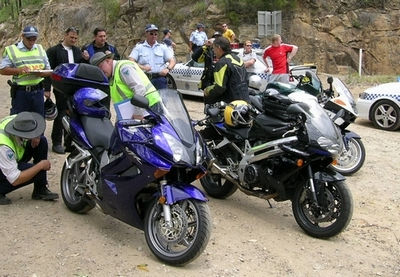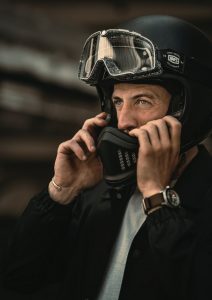
You hear lots of advice from friends and family about what to do if you are pulled over by the NSW police on your motorcycle. But which advice should you listen to?
We spoke to Chris Kalpage, a solicitor for over 35 years and specialises in traffic and criminal law. You may have heard him speak at a MCC monthly meeting. He is always generous with his time and advice to help fellow motorcyclists if they find themselves on the wrong side of the law.
An avid motorcyclist since he was 15 years old, Mr Kalpage loves sports bikes and is currently riding an Aprilia Tuono. Like most Sydney motorcyclists, his favourite roads are, the Old Pacific Highway, Putty Road and Oxley but he also loves Eastern Creek and Philip Island to let loose.
So, let’s clear it up – what should you do if you are pulled over on the side of the road by the police. We are going to assume you have been pulled over because of speeding. This is the main reason police will pull over a motorcyclist!

Firstly, pull over into a safe place as soon as the police have indicated to you.
Follow police directions. If appropriate step off the bike and remove your helmet so they can identify you.
As a blanket rule, Mr Kalpage recommends you say nothing, maintain your right to silence. If you do need to defend yourself down the track, your lawyer can work out your defence.
However, in certain traffic matters, silence may not always be possible. There may be circumstances where you will need to give the police limited information. If in doubt, contact a lawyer at the roadside. Always assume you do not know why the police officer has pulled you over. Do not make any admissions to the police officer and always be polite and avoid a roadside argument.
The highway patrol police (HWP) will be recording the conversation both audio and video. If it isn’t the HWP, the police officer will be taking notes of your responses.
Mr Kalpage suggests some questions you can ask the police officer –
After your dealings with the police officer, there is some important information to collect from the roadside. This may help you if you need to defend yourself, as indicated by Mr. Kalpage.
Take photographs of where the incident happened, from both points of view. From the direction you were travelling, as well as from the police officers’ point of view (where they said they assessed your speed from).
Note any obstructions or points of interest. Anything that may have obscured or disrupted the speed reading.
Taking photographs provides evidence of the conditions surrounding the offence. The road may have changed, signage altered, foliage different from when the date of the offence occurred and when your court case takes place.
If you have the capacity on your sat-nav or smart phone, take the exact longitude and latitude coordinates of the point from where the incident was said to have taken place.
If you do decide to challenge the allegation, it may be months before it is heard in court. You may not remember exactly the point in the road where it occurred. Long country roads in particular start to look the same.
Try to assess the distance you would have travelled from when the officer first observed you and started their test. This distance is relevant depending on the speed that is alleged and accordingly, the available time the police officer had to conduct the test.
Therefore, consider the following –
You now have some good information if you decide to seek expert legal advice regarding your allegation of speeding.
Generally, the NSW Police use four methods by which to assess speed (for the moment excluding fixed and mobile speed cameras) listed here in descending order of accuracy:
Often the police will use one of the first 3 methods above combined with their estimate.
The MCC of NSW has more information here regarding road traffic law in a series of questions and answers.
As always, safe riding.
The article as written is for your information and interest only and is based on New South Wales law only. It is not intended to be comprehensive and does not constitute and must not be relied on as legal advice. Please be aware that every case is different, and the matters raised may not be of specific relevance to your situation but may have a general application. You must seek specific advice tailored to your circumstances.
Contact Info
The Motorcycle Council of NSW Inc.
PO Box 517
Parramatta 2124
Ph: 1300 679 622 (1300 NSW MCC)
General Enquiries
Please direct enquiries to:
MCCNSW Email
enquiries@mccofnsw.org.au
Site Menu